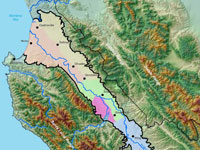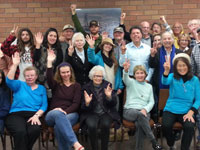
$63.00 donated in past month
|
A bulldozer rumbled into the Beach Flats Community Garden early Thursday morning, March 24, tearing out mature fruit trees and nopales plants that city staff had earlier promised would not be touched, and damaging an already strained relationship between the City and community. Despite the loss of land, fruit trees, and nopales, the Beach Flats Gardeners are committed to making the best of the 2016 planting season.

The California Department of Pesticide Regulation released the results of annual pesticide use reporting – the only reporting like it in the country – offering a glimpse into what potentially hazardous pesticides are being used in the state. Despite fewer plantings and crop loss due to the drought across the state, hazardous pesticide use increased in some counties. From 2013 to 2014, in Monterey and Santa Cruz Counties, such pesticide use increased 10.0% and 9.4%, respectively.
After conducting an analysis of the 2014 data, Mark Weller, co-director of Californians for Pesticide Reform, released the following statement: “Pesticides, whether they are sprayed, fumigated or air blasted, are used in troubling amounts across California. This is particularly true and concerning near the state’s most vulnerable populations, including schoolchildren." In particular, use of Dow’s cancer-causing soil fumigant Telone (1,3-Dichloropropene) increased with use more concentrated on fewer acres. Use of the soil fumigant chloropicrin also increased to the highest levels reported in California in at least a decade, and saw double digit percentage increases in Monterey (12.3%) and Santa Cruz (18.3%) Counties.
Read More | See Also: New Report Links Pesticides Used in Combination Near Schools to Increased Cancer Risk
Previous Coverage: New Report: Fumigant Pesticides Put Central Coast Communities At Risk | California's New “Recommended Restrictions” for Chloropicrin are Inadequate | Groundbreaking Report Finds High Rates of Pesticide Use Near Monterey County Schools

Oil companies use dozens of extremely hazardous chemicals to acidize wells in California, raising water contamination and public-safety concerns, according to a new study in the Journal of Toxicological and Environmental Chemistry.
The University of California-Los Angeles study, which has national significance because it seems to be the first ever to examine the toxicity of acidization chemicals, finds that almost 200 different chemicals have been used in the process, which is frequently employed in urban areas of Los Angeles County.
Researchers at UCLA’s Institute of the Environment and Sustainability found that at least 28 of these substances are F-graded hazardous chemicals — carcinogens, mutagens, reproductive toxins, developmental toxins, endocrine disruptors or high acute toxicity chemicals. Hydrofluoric acid, for example, is acutely toxic, and exposure to fumes or very short-term contact with its liquid form can cause severe burns.
Read More | Center for Biological Diversity
With the hope of nudging the city forward toward making good on its months-old public promise to initiate permanent investment in the Beach Flats Community Garden, and under imminent threat of legal proceedings against them, on February 16 the gardeners of Beach Flats decided to sign a city letter acquiescing to temporarily leaving the garden plots they have tended so carefully over the past two decades.

On February 18, the U.S. Fish and Wildlife Service announced the reclassification of the Santa Cruz cypress from “endangered” to “threatened” status under the Endangered Species Act. The tree was protected in 1987 due to threats to its habitat, but now the habitat for all five populations is secure.
The cypress is found only in the Santa Cruz Mountains of California, in Santa Cruz and San Mateo counties. This compact, coniferous tree with dense, cone-producing branches thrives in coastal chaparral communities above the fog belt. Before the Santa Cruz cypress was protected under the Act, it faced intense pressure from development, logging, disease and competition from non-native species, which ultimately stifled its ability to repopulate and thrive in its historic habitat. Through the cooperative efforts of local, state and federal agencies, most of the trees now live in fully protected areas.
The recovery plan developed by federal scientists determined that the cypress, which now numbers between 33,000 to 44,000 trees, could be downlisted once all five of its populations were protected from threats that include development, non-native species and unauthorized trail-building. Though the exact number of trees at the time of listing was unknown, the Service estimated there were only around 2,300.
 Read More
Previous Coverage: California's Santa Cruz Cypress Recovering, Ready for Downlisting Read More
Previous Coverage: California's Santa Cruz Cypress Recovering, Ready for Downlisting
Norman “Wounded Knee” DeOcampo (Miwok), a long-time resident of Vallejo, will be taking part in the Longest Walk 5 beginning February 13 at La Jolla Shores in San Diego, California. Wounded Knee is the Founding Executive Director of the Vallejo based organization Sacred Sites Protection and Rights of Indigenous Tribes. (SSPRIT). He is the only person who will have participated in all five Longest Walks.
On February 9, hundreds of people marched through downtown Santa Cruz from the Beach Flats Community Garden to the City Council meeting. Gardeners, along with a large coalition of supporters, are seeking a creative solution to preserve twenty five years of cultivating food and culture in the heart of the Beach Flats.
At about 10 am on February 3, a gardener and supporter of the Beach Flats Community Garden relayed the following information via text message, "City is clearing out gardeners stuff right now." By noon, a fence was up and the city's crew was gone. On the previous day, supporters of the garden announced the launch of a grassroots fundraising campaign to assist the City of Santa Cruz in purchasing the current garden from the Seaside Company, but the city is threatening legal action.

Monterey County has a total of 44 active or idle wastewater injection wells. There are 261 water supplying wells within 1 mile of these wastewater injection wells, likely wells for nearby ranches, farms and rural residences. Most of these wastewater injection wells are in San Ardo oil fields.
In May 2015, DOGGR sent to EPA a list of California’s class II wastewater injection wells that are injecting into protected aquifers. In Nov 2015, the Central Coast Regional Water Quality Control Board sent letters to oil and gas operators whose wastewater injection wells are injecting into protected aquifers. The wells listed will be shut down by February 2017 unless the operators get an “aquifer exemption.” The DOGGR is holding public hearings about whether to grant aquifer exemptions. A big crowd turned out for the DOGGR aquifer exemption hearing in San Luis Obispo. Monterey County’s DOGGR hearing has not yet been scheduled.
Both DOGGR and the EPA acknowledge that 80% of Monterey’s wastewater injection wells (35 out of 44) put at risk aquifers that should be protected. In July, 2014, the state found that the industry had illegally injected about 3 billion gallons of fracking wastewater, containing high levels of arsenic, thallium, and nitrates, into central California drinking-water and farm-irrigation aquifers, and DOGGR issued cease and desist orders.
Protect Monterey County (PMC) is an organization working to pass a citizens' initiative to prevent the harmful impacts of extreme oil extraction methods. Protect Monterey County is organizing county-wide working sessions to get the fracking ban initiative on the ballot for November 2016. Meetings are set for Monterey Peninsula activists 1st and 3rd Wednesdays, 6:30 pm at the Peace & Justice Center, 1364 Fremont, Seaside. For the Salinas area, Hartnell College on 2nd and 4th Wednesdays at the Admin Bldg. Room E112.
Wednesday, February 3:  Protect Monterey County meeting in Seaside Protect Monterey County meeting in Seaside
 Read More | Protect Monterey County website Read More | Protect Monterey County website

On January 11, contractors with the UC administration began construction work on the southern portion of the Gill Tract, a historical farm sold to the University of California in 1928 under the condition it would be used for agricultural research and education. The UC is privatizing this section of the Gill Tract for the construction of a high-end senior assisted living facility by the Belmont Village corporation, alongside construction of a Sprouts supermarket and a parking lot.
The next day after working hours, about fifteen individuals entered the Gill Tract to remove surveying stakes marking the paths for the heavy machinery brought to pave over the last large-scale plot of high-quality urban farmland still available on the East Bay. The mobilization by the group Occupy the Farm was led by senior citizens from the community.
On January 28, farm defenders chained themselves to an excavator that was removing valuable topsoil. This halted a day of construction over the contested farmland. “We have tried every formal and institutional route for a more democratic decision on the fate of this land,” explains Gustavo Oliveira, a PhD student of geography at UC Berkeley and member of Occupy the Farm.
  Farm defenders halt construction over farmland in the East Bay | Farm defenders halt construction over farmland in the East Bay |
 Farm defenders disrupt destruction of farmland and inauguration of supermarket in the East Bay
Previous Related Indybay Feature:
Indigenous Land Access Committee Holds Ongoing Ceremony on Gill Tract to Reclaim Land Farm defenders disrupt destruction of farmland and inauguration of supermarket in the East Bay
Previous Related Indybay Feature:
Indigenous Land Access Committee Holds Ongoing Ceremony on Gill Tract to Reclaim Land
8PM Friday Apr 29
Word to Our Mother
|
|
 The California Department of Pesticide Regulation released the results of annual pesticide use reporting – the only reporting like it in the country – offering a glimpse into what potentially hazardous pesticides are being used in the state. Despite fewer plantings and crop loss due to the drought across the state, hazardous pesticide use increased in some counties. From 2013 to 2014, in Monterey and Santa Cruz Counties, such pesticide use increased 10.0% and 9.4%, respectively.
The California Department of Pesticide Regulation released the results of annual pesticide use reporting – the only reporting like it in the country – offering a glimpse into what potentially hazardous pesticides are being used in the state. Despite fewer plantings and crop loss due to the drought across the state, hazardous pesticide use increased in some counties. From 2013 to 2014, in Monterey and Santa Cruz Counties, such pesticide use increased 10.0% and 9.4%, respectively.



















